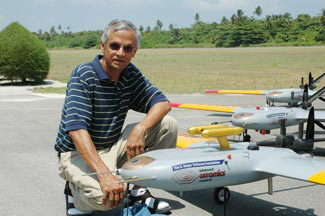|
Web Extra Friday, August 3, 2007
Soot warms, not cools the atmosphere
 Scripps Institution of Oceanography, UC San Diego |
| Veerabhadran Ramanathan and his team used these unmanned aerial vehicles that flew over the Indian Ocean in March 2006 to measure aerosols and solar radiation in atmospheric brown clouds. |
The brown, hazy clouds that hover above South Asia and float over the Indian Ocean during the dry season may be to blame for more than just dirty skies. New research has found that the sooty brown clouds, caused primarily by the burning of coal and other organic materials in India, China and other parts of South Asia, may be responsible for some of the atmospheric warming that had been attributed to greenhouse gases.
Atmospheric brown clouds are composed of particles suspended in the air, called aerosols, whose contribution to climate change is poorly understood. Because aerosols can scatter solar radiation and reflect it into space, climate models have traditionally attributed a net cooling effect to aerosols. But when aerosols contain black carbon from soot, which is released from burning organic materials, the aerosol particles actually absorb radiation and heat the atmospheric layers in which they’re found, according to a study conducted by Veerabhadran Ramanathan, director of the Center for Clouds, Chemistry and Climate at the Scripps Institution of Oceanography in La Jolla, Calif., and colleagues, published Aug. 2 in Nature. These clouds are thus likely responsible for warming that was previously attributed to greenhouse gases, the team wrote. Furthermore, the authors suggest that solar heating from the brown clouds may have hastened the retreat of the Himalayan glaciers in recent decades.
The researchers dispatched unmanned aerial vehicles over the Indian Ocean during March 2006, when the dry season pollution was most prevalent. During 18 separate missions, they measured aerosol particle concentrations, quantity of soot and solar radiation at three different elevations, from half a kilometer to three kilometers above the ocean surface. Atmospheric brown clouds, they found, increased atmospheric heating by about 50 percent. In fact, the team found that warming due to brown clouds was almost a one-to-one ratio with the warming produced by greenhouse gases. Black soot was responsible for most of the heating in the brown clouds, as visible radiometer measurements indicated that visible wavelengths accounted for much of the absorbed radiation, Ramanathan and colleagues wrote.
Considering current climate models generally attribute a net cooling effect from brown clouds, a “rethink” might be in order, according to Peter Pilewskie of the University of Colorado at Boulder, who wrote an accompanying commentary in the same issue of Nature. Although other researchers have gathered field data on aerosols, Ramanathan’s team used a particularly sophisticated and efficient means of measurement, finding “the crucial data” that had been missing from model and satellite estimates, Pilewskie wrote.
To determine whether aerosol plumes were responsible for warming beyond the Indian Ocean, the researchers incorporated satellite data and surface observations from a previous study and the data from this study into general circulation models. They modeled monthly heating rates in atmospheric brown clouds that hover over southern and eastern Asia, and simulated both solar heating in brown clouds and warming due to greenhouse gases from 1950 to 2000. They found that the amount of warming due to atmospheric brown clouds was roughly equal to that of greenhouse gases— between 0.5 and 0.8 degrees Celsius per decade between the elevations of two and five kilometers.
Atmospheric heating from the brown clouds may thus warm the surface air over the Himalayas, the team says, where temperatures in recent years have increased by 0.15 to 0.3 degrees Celsius per decade during the last several decades. The consequent melting of the glaciers that feed the Yangtze, Indus and Ganges rivers could have “unprecedented downstream effects on southern and eastern Asia” if the warming continues unabated, the team wrote.
“It is a very neat experiment,” says Sjaak Slanina, a professor of atmospheric chemistry at Peking University. The team’s methods were sound, he says, and application of the data into general circulation and radiation models is a good step. He cautions against assuming that the atmospheric brown clouds over the Himalayas absorb and reflect radiation in the same way the as those observed over the Indian Ocean, however, as the chemical composition of aerosols can change during transport.
Given the apparent discrepancy between Ramanathan’ s team’s findings and how current models consider aerosols, this paper emphasizes “the importance of resolving how aerosol radiative forcing varies with elevation,” Pilewskie wrote. NASA’s Glory mission, set to launch his fall, he said, should help resolve the question, as it is designed to collect aerosol particle information not currently available.
Links:
"Soot from Indian cooking," Geotimes, May 2005
Back to top

 Subscribe
Subscribe


